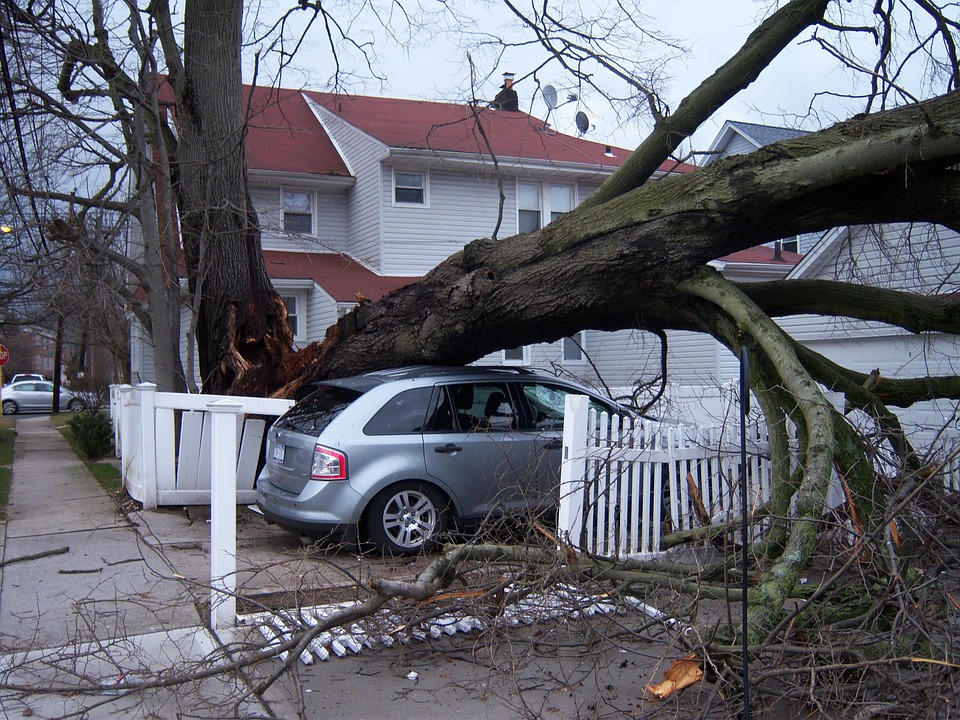Does UV Light Kill Mold?

The answer is yes, UV light emerges as a promising solutionA solution is a homogeneous mixture of two or more substance... More in the fight against moldMold is a type of fungus that grows in damp or humid conditi... More. MoldMold is a type of fungus that grows in damp or humid conditi... More is prevalent throughout the natural world. The sporesSpores are microscopic reproductive units of fungi or mold t... More help organisms, like dead trees and leaves, decompose. But when moldMold is a type of fungus that grows in damp or humid conditi... More colonies infest the home, they pose a danger. Fortunately, UV light is known to effectively kill the pesky moldMold is a type of fungus that grows in damp or humid conditi... More. Here’s how UV light works in eradicating moldMold is a type of fungus that grows in damp or humid conditi... More.
What is Mold?
MoldMold is a type of fungus that grows in damp or humid conditi... More, a type of fungus, is a small organism that plays an essential role in breaking down organic matter in nature. However, when it infiltrates indoor spaces, it can cause damage to various surfaces such as damp drywall, carpeting, and clothing. MoldMold is a type of fungus that grows in damp or humid conditi... More not only deteriorates materials but also poses health risks, especially for individuals with respiratory issues or allergies. MoldMold is a type of fungus that grows in damp or humid conditi... More sporesSpores are microscopic reproductive units of fungi or mold t... More, which are airborne, can trigger allergic reactions and exacerbate asthma symptoms when inhaled. Some molds even produce harmful substances known as mycotoxinsMycotoxins are toxic substances produced by certain types of... More, which can further complicate the health risks associated with indoor moldMold is a type of fungus that grows in damp or humid conditi... More growth.
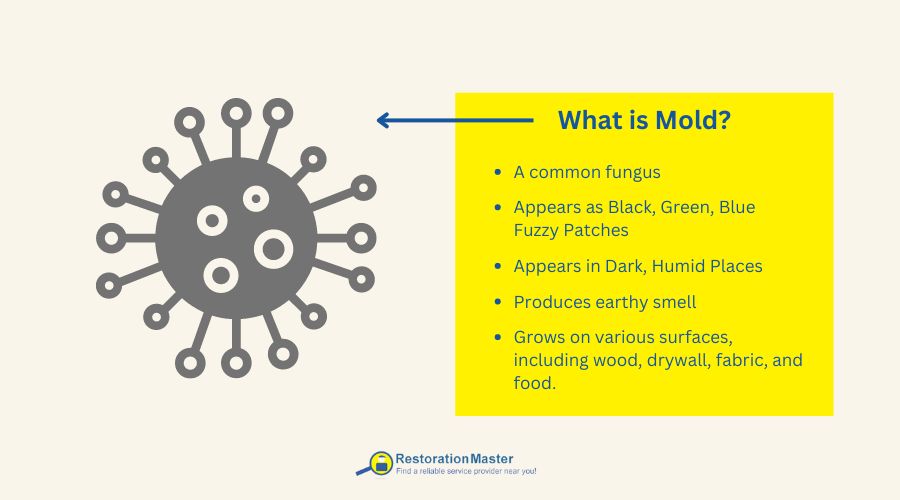
What Does Mold Need to Survive?
MoldMold is a type of fungus that grows in damp or humid conditi... More doesn’t need much to thrive. It thrives on just a few things: constant moisture, darkness, and organic material like drywall. Moisture, whether from a leaky pipe or elsewhere, is its lifeline. Darkness provides the cover it needs to grow undisturbed. And organic materialsOrganic materials are derived from living organisms, such as... More serve as its food source. With these conditions met, moldMold is a type of fungus that grows in damp or humid conditi... More can spread rapidly, turning ordinary spaces into breeding grounds. It’s a testament to mold’s adaptability and resilience in finding what it needs to survive.
Why Should Mold Be Removed?
Eliminating moldMold is a type of fungus that grows in damp or humid conditi... More isn’t just a matter of cleaning up; it’s about protecting health and preserving the integrity of a building. When moldMold is a type of fungus that grows in damp or humid conditi... More sporesSpores are microscopic reproductive units of fungi or mold t... More infiltrate a home, they bring respiratory issues like sneezing, watery eyes, and itchy skin for occupants. These symptoms can quickly make the indoor environment uncomfortable and potentially harmful. Additionally, moldMold is a type of fungus that grows in damp or humid conditi... More feeding on drywall and other building materials gradually weakens the structureStructure refers to the framework or components of a buildin... More, raising safety concerns. Weakened walls or ceilings can leadLead is a heavy metal that can be toxic to humans, especiall... More to collapse or other accidents. Thus, mold removal isn’t just cosmetic; it’s crucial for maintaining both health and safety.
How is Mold Eliminated?
MoldMold is a type of fungus that grows in damp or humid conditi... More elimination presents various options, including common household products like chlorine bleach, hydrogen peroxide, vinegar, and baking soda. While chlorine bleach effectively eradicates moldMold is a type of fungus that grows in damp or humid conditi... More on non-porous surfaces, its penetration into porousPorous describes a material that contains small openings or ... More materials is limited. Hydrogen peroxide offers a safer alternative, eliminating moldMold is a type of fungus that grows in damp or humid conditi... More without emitting harmful fumes. Vinegar, renowned for its antimicrobial properties, serves as a natural option, albeit potentially less potent against certain moldMold is a type of fungus that grows in damp or humid conditi... More strains. Baking soda aids in scrubbing away moldMold is a type of fungus that grows in damp or humid conditi... More and absorbing moisture, though it lacks disinfectantA disinfectant is a chemical substance used to kill or inact... More properties. However, a novel solutionA solution is a homogeneous mixture of two or more substance... More gaining traction is UV light. UV light disrupts moldMold is a type of fungus that grows in damp or humid conditi... More spores’ DNA, inhibiting reproduction and eventual eradication. To utilize UV light for moldMold is a type of fungus that grows in damp or humid conditi... More elimination, specialized UV lamps are required, illuminating affected areas for specified duration. While effective on exposed surfaces, UV light may not penetrate deeply into porousPorous describes a material that contains small openings or ... More materials, necessitating combined approaches for comprehensive removal. Nonetheless, UV light offers a promising, non-toxic method for addressing moldMold is a type of fungus that grows in damp or humid conditi... More issues in homes.
What is an Ultraviolet (UV) Light?
UV light, or ultraviolet light, is a type of radiationRadiation is the emission of energy in the form of waves or ... More with shorter wavelengths than visible light but longer than X-rays. It comes from the sun naturally and can also be made by special lamps.
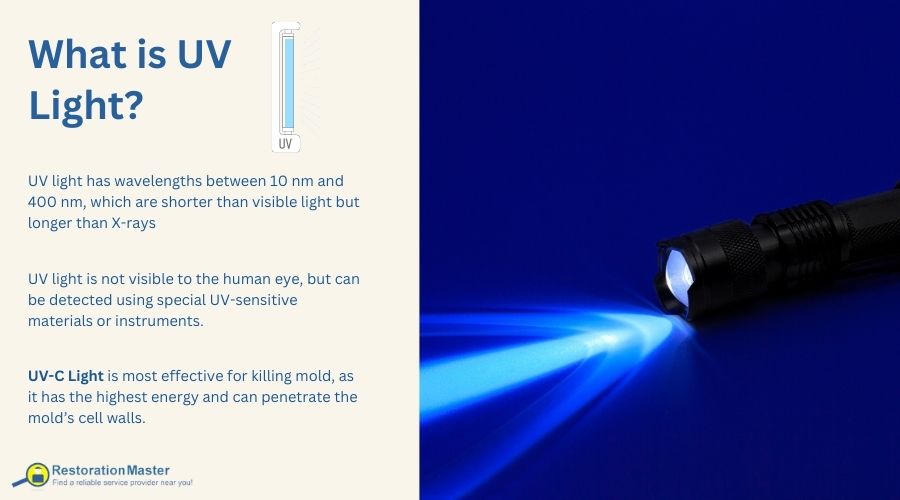
What are the Three Types of UV Light?
UV light comes from various sources. UV-A is one type of wavelength, which is commonly known as black light. The sun gives off UV-B light, causing suntans and providing a good source of vitamin D. UV-C Light is most effective for killing moldMold is a type of fungus that grows in damp or humid conditi... More, as it has the highest energy and can penetrate the mold’s cell walls. Direct exposure to UV-C light can be harmful to humans, so proper precautions should be taken to avoid skin and eye damage.
Which is the Most Effective Mold Killing UV Light?
UV-C light is recommended when attempting to eradicate moldMold is a type of fungus that grows in damp or humid conditi... More colonies. Its wavelengths are shorter than the sun’s, which gives it a germicidal effect and positions it as a powerful moldMold is a type of fungus that grows in damp or humid conditi... More eradicator. Higher intensity UV light is more effective at eliminating moldMold is a type of fungus that grows in damp or humid conditi... More than lower intensities.
Does UV Light Kill Mold?
UV light is effective at killing moldMold is a type of fungus that grows in damp or humid conditi... More by disrupting the DNA inside the moldMold is a type of fungus that grows in damp or humid conditi... More sporesSpores are microscopic reproductive units of fungi or mold t... More. When UV light comes into contact with living tissues, it causes damage by breaking chemical bonds between atoms, a process known as ionizationIonization is the process of using electrically charged part... More. The short wavelengths of UV light penetrate the moldMold is a type of fungus that grows in damp or humid conditi... More sporesSpores are microscopic reproductive units of fungi or mold t... More, where they disrupt the DNA structureStructure refers to the framework or components of a buildin... More, preventing the sporesSpores are microscopic reproductive units of fungi or mold t... More from reproducing and deactivating them. Essentially, the UV light alters the genetic material of the moldMold is a type of fungus that grows in damp or humid conditi... More, rendering it unable to function properly. This process inhibits the mold’s ability to grow and spread, ultimately leading to its demise.
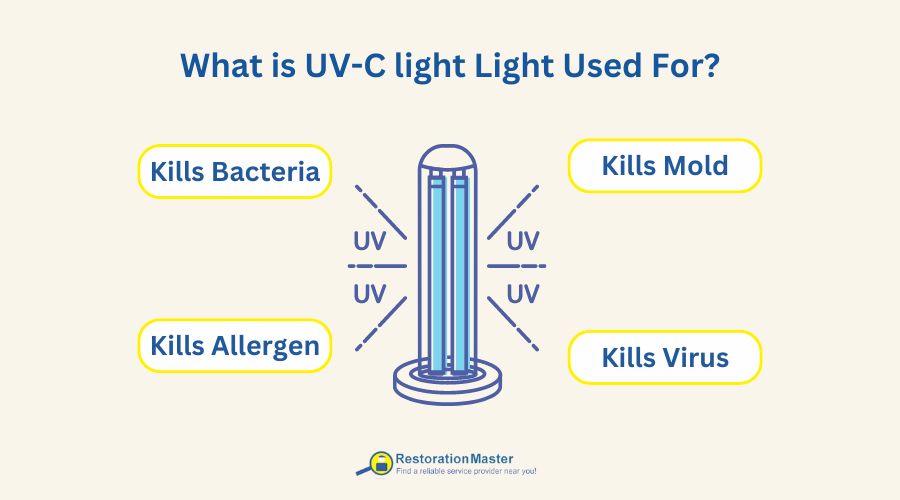
Does UV Light Work in HVAC Systems?
When used correctly, UV light has the ability to kill moldMold is a type of fungus that grows in damp or humid conditi... More anywhere in the home, even in HVAC systems. Despite its versatility, the light is most commonly placed inside air conditioning units. By installing a UV light in the HVAC ductwork system, it keeps the entire system mold-free.
The UV light essentially blankets the environment with germicidal light. As a result, it disinfects the whole area. For maximum efficacy, the UV light should be turned on for extended periods and be kept at a higher intensity. As mentioned, higher intensity UV lighting is most effective.
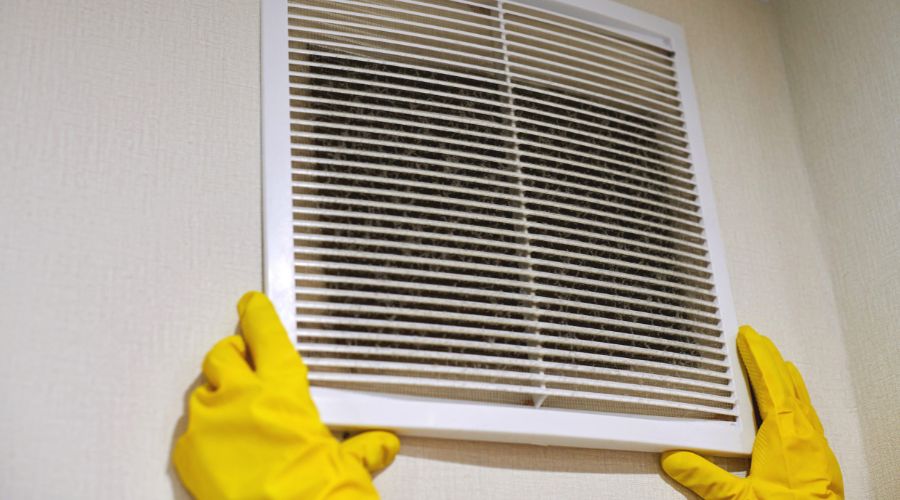
How is UV Light Used to Eliminate Mold in the HVAC?
Obtain a UV-C lamp. These lamps are available in a wide range of sizes and types to fulfill various needs, such as for use inside the HVAC system or elsewhere in the home. The two UV light options for use inside an HVAC unit are coil sanitizing and air sanitizing.
A coil sanitizing UV light should be placed near the heat pump’s evaporator coil, where most condensation develops upon the refrigerant absorbing heat. This environment is ripe for moldMold is a type of fungus that grows in damp or humid conditi... More due to the constant supply of moisture produced. The coil sanitizing light effectively kills the moldMold is a type of fungus that grows in damp or humid conditi... More.
Air-sanitizing lamps are an alternative option for placement within the HVAC return vents and ducts. The UV light sanitizes the air as it circulates through the system. Any moldMold is a type of fungus that grows in damp or humid conditi... More, bacteria, and other airborne contaminants are eliminated as a result of the process.
How Long Does the UV Light Take to be Effective?
When the HVAC ductwork is bathed in UV lighting, it takes approximately one to three hours to eliminate the moldMold is a type of fungus that grows in damp or humid conditi... More colonies. This process kills up to 99.9 percent of existing moldMold is a type of fungus that grows in damp or humid conditi... More sporesSpores are microscopic reproductive units of fungi or mold t... More. Keep the light source about two inches away from the suspected moldMold is a type of fungus that grows in damp or humid conditi... More for the best results.
UV lighting used to eradicate moldMold is a type of fungus that grows in damp or humid conditi... More is an effective solutionA solution is a homogeneous mixture of two or more substance... More. Though it is costly to purchase (priced between $100 and $1,000), the UV lights save the homeowner time and effort in manually removing moldMold is a type of fungus that grows in damp or humid conditi... More. But without protection, exposure to UV rays can be harmful to the eyes and skin.
Combined with other moldMold is a type of fungus that grows in damp or humid conditi... More removal tacticsTactics are the specific methods or actions used to achieve ... More, UV lights may be a worthwhile investment. UV lights not only fully kill the sporesSpores are microscopic reproductive units of fungi or mold t... More but prevent them from returning. Homeowners who’d like to fit UV lights in their HVAC system should consult a professional for safe and proper installation.
RestorationMaster MoldMold is a type of fungus that grows in damp or humid conditi... More Removal Services
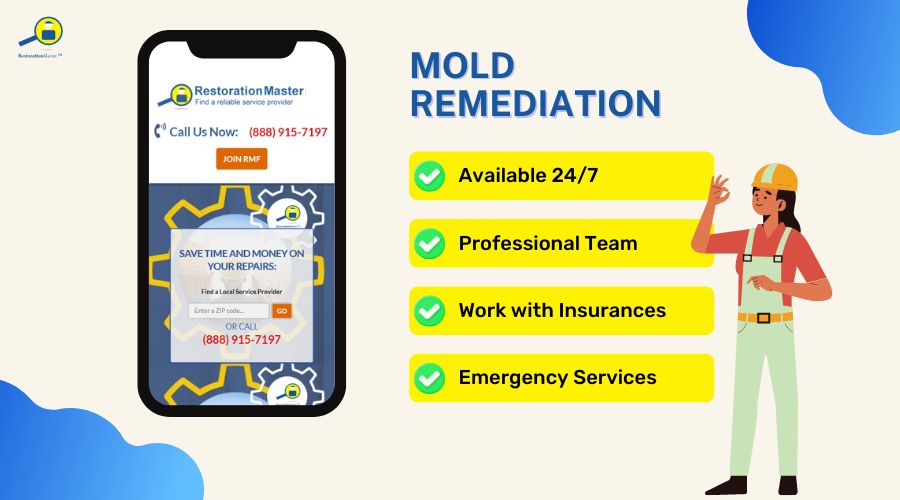
When you see or smell moldMold is a type of fungus that grows in damp or humid conditi... More in your home, whether in the HVAC unit or elsewhere, it must be eliminated fast. The mold remediationMold remediation is the process of identifying, removing, an... More are prepared to address your moldMold is a type of fungus that grows in damp or humid conditi... More problem and return your property to a mold-free condition quickly.
Professional moldMold is a type of fungus that grows in damp or humid conditi... More removal methods are highly effective. Trained technicians arrive at your home to assess the extent of the infestation and identify the source of the moisture causing the moldMold is a type of fungus that grows in damp or humid conditi... More. They then repairRepair is the act of fixing or restoring damaged property, m... More the moisture issue to prevent future moldMold is a type of fungus that grows in damp or humid conditi... More outbreaks.
High-tech equipment detects all traces of hidden and visible mold—whether the moldMold is a type of fungus that grows in damp or humid conditi... More grows concealed under the carpets and behind walls or flourishes in plain sight in the basement nooks and crannies. They can also perform effective HVAC mold removal.
Professionals contain the affected space to prevent sporesSpores are microscopic reproductive units of fungi or mold t... More from spreading to other parts of the home. The moldMold is a type of fungus that grows in damp or humid conditi... More colonies are cleaned and contaminated materials are removed. A thorough disinfecting and cleaning are performed to eliminate any lingering moldMold is a type of fungus that grows in damp or humid conditi... More sporesSpores are microscopic reproductive units of fungi or mold t... More. The area is then dried to prevent moldMold is a type of fungus that grows in damp or humid conditi... More from returning.
Frequently Asked Questions (FAQs)
Can sunlight kill mold?
The UV rays in sunlight can damage and kill moldMold is a type of fungus that grows in damp or humid conditi... More sporesSpores are microscopic reproductive units of fungi or mold t... More on surfaces that get direct exposure. However, it might not be enough to completely get rid of moldMold is a type of fungus that grows in damp or humid conditi... More, especially in hidden or shaded areas. For best results, combine sunlight with other cleaning methods and fix any moisture problems.










